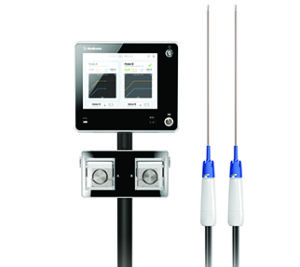
Medtronic has announced that the US FDA has cleared an expanded indication for the OsteoCool radiofrequency (RF) ablation system.
Originally cleared for use in the spine, the FDA now allows the marketing of the OsteoCool system for palliative treatment of metastases in all bony anatomy—such as ribs, sacrum, extremities, and hip—in patients who have failed, or are not candidates, for standard therapy. The system uses targeted radiofrequency energy to ablate malignant metastatic bone tumours.
“Patients with metastatic bone cancer may be treated with conventional therapies such as opioids, chemotherapy or radiation therapy for pain palliation,” said Sandeep Bagla, an interventional radiologist with the Vascular Institute of Virginia in Woodbridge, USA. “With the expanded indication for the OsteoCool system, I now have the option to ablate these patients’ painful bone tumours when conventional therapies are considered ineffective, too slow-acting or cause unacceptable side effects.”
Metastatic bone disease has been reported to occur in 60–80% of cancer patients, most frequently among patients with primary malignancies of the breast, prostate, liver, and lung. More than 80% of bone metastases are found in the axial skeleton, which includes the skull, spine, and ribs.
Medtronic acquired the OsteoCool technology and associated intellectual property from Baylis Medical on 16 December 2015 and partnered with the company to further innovate the system.
The OsteoCool system is the only cooled radiofrequency ablation technology that offers simultaneous, dual-probe capabilities providing for procedural flexibility and predictable, customised treatment, a press release from Medtronic states. The system is temperature controlled and uses internally water-cooled probes to prevent overheating of surrounding tissue during the procedure, it adds.
The device also has a CE mark for the ablation of benign bone tumours such as osteoid osteoma and palliative treatment of metastatic malignant lesions involving bone, including the vertebral body. This indication is not available in the USA.









